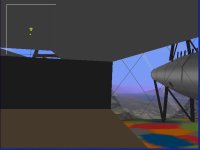aleatorylamp
Charter Member
Flight model satisfaction
Hi Ivan,
It´s interesting that you know how to make useful programs - they come in handy! I can only program in QBASIC, and it´s a bit obsolete now... I haven´t learnt to use spread sheets either, so I´m limited to manual entries in AirEd, but it´s not too bad at all with CFS1!
To compare 2 .air files I always open 2 windows with AirEd open side by side, and go down both listings in order, and it works OK.
After the FS98 limitations that I have been used to until now, it is indeed satisfying to experience the increased control that CFS1 offers over aircraft performance! The main problems I ran into towards the end were my own fault, as I should have noticed that the .air file had something "broken" in it and renewed it long before. Anyway, I have just adjusted the second Giant´s better engines for 8200 ft rated altitude, and Hp is fine all round... I´m now adjusting RoC for different altitudes.
You mention fuel tanks: An interesting thing on the Giant was that it was fuel-trimmed. Prior to take-off, the angle of attack for the sustaining tailplane was set from outside, depending on the bombload to be carried, and then the plane was tanked up, always leaving the 2 foremost of the cylindrical inboard fuselage tanks empty. The Mercedes engined Giant had 8 tanks, and the Maybach one, 10. This way the plane was trimmed for take-off and climb. Then during flight, the fuel engineer could pump fuel into the two foremost tanks to change the CoG for level flight. He also kept the central tank under the top wing full to feed the engines.
A trimming-wheel was also available - it is visible on cockpit photos, but only used when the plane was empty and low on fuel, and there was nothing to pump into the forward tanks to lower the nose.
Anyway, in CFS there´s no fuel menu, so one can´t move the fuel around from one tank to another and the trimming wheel has to be used. For CFS1 I have only defined 2 fuel tanks, left and right, each with half the total fuel.
I´ll wait a bit for your notes on the V-Cockpit then, before I upload the Mercedes Giant.
Cheers,
Aleatorylamp
Hi Ivan,
It´s interesting that you know how to make useful programs - they come in handy! I can only program in QBASIC, and it´s a bit obsolete now... I haven´t learnt to use spread sheets either, so I´m limited to manual entries in AirEd, but it´s not too bad at all with CFS1!
To compare 2 .air files I always open 2 windows with AirEd open side by side, and go down both listings in order, and it works OK.
After the FS98 limitations that I have been used to until now, it is indeed satisfying to experience the increased control that CFS1 offers over aircraft performance! The main problems I ran into towards the end were my own fault, as I should have noticed that the .air file had something "broken" in it and renewed it long before. Anyway, I have just adjusted the second Giant´s better engines for 8200 ft rated altitude, and Hp is fine all round... I´m now adjusting RoC for different altitudes.
You mention fuel tanks: An interesting thing on the Giant was that it was fuel-trimmed. Prior to take-off, the angle of attack for the sustaining tailplane was set from outside, depending on the bombload to be carried, and then the plane was tanked up, always leaving the 2 foremost of the cylindrical inboard fuselage tanks empty. The Mercedes engined Giant had 8 tanks, and the Maybach one, 10. This way the plane was trimmed for take-off and climb. Then during flight, the fuel engineer could pump fuel into the two foremost tanks to change the CoG for level flight. He also kept the central tank under the top wing full to feed the engines.
A trimming-wheel was also available - it is visible on cockpit photos, but only used when the plane was empty and low on fuel, and there was nothing to pump into the forward tanks to lower the nose.
Anyway, in CFS there´s no fuel menu, so one can´t move the fuel around from one tank to another and the trimming wheel has to be used. For CFS1 I have only defined 2 fuel tanks, left and right, each with half the total fuel.
I´ll wait a bit for your notes on the V-Cockpit then, before I upload the Mercedes Giant.
Cheers,
Aleatorylamp


